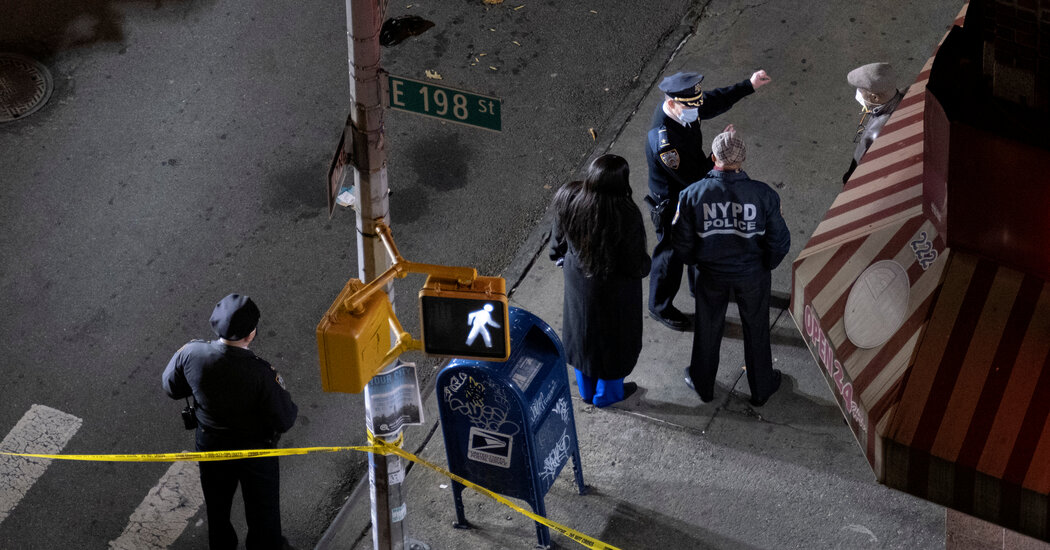In recent days in New York, a woman was shoved to her death from a subway platform. A baby was hit by a stray bullet in the face. A police officer was fatally shot.
The disregard for human life comes after two grinding years of death. First from the coronavirus and now from a rise in gun violence.
New York remains among the safest large cities in America. There were 488 homicides last year — a far cry from the early 1990s, when the city saw more than 2,000 murders in a year. Still, the atmosphere of unease and despair in many parts of the city today is real. It can be seen in the city’s subways, where those struggling with mental illness and homelessness have been left to languish. It is in Times Square, where the hallmarks of drug addiction are present at all hours. It can be felt in some of the poorest neighborhoods in the city, whose residents are bearing the brunt of the increase in violence.
Getting crime under control and quashing any growing unease that the bad old days could return is critical to the city’s revival. So is doing it in a thoughtful manner.
On Monday, Mayor Eric Adams laid out his administration’s wide-ranging approach to crime in a long midday television address. “We will not surrender our city to the violent few,” he said. “Safety and justice are prerequisites for prosperity. Gun violence is a public health crisis. There’s no time to wait.”
Mr. Adams’s immediate job is to direct the New York Police Department toward policing that targets violent crime. The mayor said the department would deploy more officers to subways and to the 30 precincts that have seen some 80 percent of recent violent crime. He also said the N.Y.P.D. will form a uniformed anti-gun unit to replace the long-troubled plainclothes anti-crime units, which were disbanded in 2020.
The challenge will be how to make the city safer without reverting to the overpolicing, especially in Black and Latino communities, seen under previous mayors. Mr. Adams promised better oversight of the new anti-gun units, and in the coming days, New Yorkers deserve to know more about what that oversight will be and how it will work.
It was promising to hear the mayor focus on jobs for young people. Saying that roughly 250,000 people ages 16 to 24 are neither in school nor employed, he promised an “unprecedented” summer jobs program for youth. That’s a good start, but ultimately, these young people will need the skills and help to find permanent, well-paying jobs.
Other proposals by the mayor deserve more scrutiny. One of his ideas — allowing 16- and 17-year-old repeat offenders arrested on gun charges to be charged in criminal court instead of family court — should be a nonstarter.
Mr. Adams also said he would campaign to roll back provisions in the state’s 2019 bail reforms and push for a change that would again allow judges to consider “dangerousness” when setting bail. If these changes will make New Yorkers safer, lawmakers should consider them. But the burden of proof lies with those who want to undo these important reforms.
The causes of crime are complex, and New York’s rise in shootings mirrors a national trend. Homicides during the pandemic, for instance, have been on the rise in cities run by Republicans and Democrats, cities that liberalized their anti-crime policies and those that did not. So far, opponents of New York’s criminal justice reforms have not yet made the case that reforms directly fueled a rise in crime, and in the meantime, the new Manhattan district attorney, Alvin Bragg, has made clear he remains committed to prosecuting serious crime.
Lasting solutions to what ails New York City will go beyond the police and prosecutors. They will require buy-in from leaders across the state, as well as public money to pay for them.
New York needs more supportive housing and services for people confronting mental illness and addiction, rather than allowing these vulnerable individuals to languish in subway stations.
The city needs a Police Department laser focused on fighting violence while still respecting the civil liberties of residents in the city it is entrusted to protect. That work likely includes more funding for community anti-violence groups that have been credited with preventing gun crimes over the past decade. This would be made easier if Washington could enact common-sense gun laws to end the so-called iron pipeline that sends guns from less restrictive states in the South and Midwest to cities like New York.
It was especially encouraging on Monday to hear Mr. Adams vow to work with the state to strengthen New York’s mental health infrastructure. The best case would be to see Mr. Adams and Gov. Kathy Hochul join forces and commit to building the housing and mental health infrastructure needed to address the most intractable part of the city’s homelessness crisis head-on.
The right solutions aren’t quick, easy or conducive to political touchdowns. But they will make New York a safer, healthier and more humane place to live, work and visit. With new leadership at City Hall, in Albany and at the Manhattan district attorney’s office, New York has an opportunity to get this right. A weary city is waiting.
The Times is committed to publishing a diversity of letters to the editor. We’d like to hear what you think about this or any of our articles. Here are some tips. And here’s our email: letters@nytimes.com.
Follow The New York Times Opinion section on Facebook, Twitter (@NYTopinion) and Instagram.




























